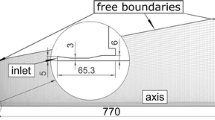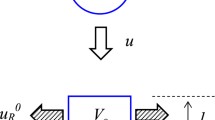Abstract
Transport between droplets/particles and a gas phase plays an important role in numerous material processing operations. These include rapid solidification operations such as gas atomization and spray forming, as well as chemical systems such as flash furnaces. Chemical reaction rates and solidification are dependent on the rate of gas-particle or gas-droplet transport mechanisms. These gas-based processes are difficult to analyze due to their complexity which include particle and droplet distribution and the flow in a gas field having variations in temperature and velocity both in the jet cross-section and in the axial distance away from the jet source. Thus to study and properly identify the important variables in transport, these gas and droplet variations must be eliminated or controlled. This is done in this work using models based on a single fluid atomization system. Using a heat transport model (referred to as thermal model) validated using single fluid atomization of molten droplets and a microsegregation model, the effect of process variables on heat losses from droplets was examined. In this work, the effect of type of gas, droplet size, gas temperature, gas-droplet relative velocity on the heat transport from AA6061 droplets was examined. It is shown that for a given gas type, the most critical process variable is the gas temperature particularly as affected by two-way thermal coupling and the droplet size. The results are generalized and applied to explain the difference in droplet cooling rate from different atomization processes.













Similar content being viewed by others
Abbreviations
- A :
-
Surface area of the droplet
- Cp :
-
Heat capacity of the droplet
- Cp m :
-
Integral heat capacity
- f s :
-
Fraction solid
- Fo*:
-
Modified Fourier number for droplet-gas thermal transport
- h total :
-
Total heat transfer coefficient
- h conv :
-
Convective heat transfer coefficient
- H :
-
Droplet enthalpy
- k s :
-
Gas thermal conductivity
- ΔLatent:
-
Solidification enthalpy
- m and (m + 1):
-
Indices for the numerical calculation
- Nu :
-
Droplet Nusselt number
- Pr :
-
Prandltl number
- Re :
-
Droplet Reynolds number
- t :
-
Time
- t*:
-
Reference time
- t f :
-
Solidification time
- T liq :
-
Liquidus temperature of AA6061
- T m :
-
Droplet temperature during solidification
- T nuc :
-
Nucleation temperature for simulation
- T sol :
-
Solidus temperature of AA6061
- Tu :
-
User-defined primary undercooled temperature
- T ∞ :
-
Gas temperature in the free stream
- V :
-
Volume of the droplet
- ρ :
-
Droplet density
- μbulk :
-
Gas viscosities at the temperature of the free flow gas
- μsurf :
-
Gas viscosities at the temperature of the droplet
- θ :
-
Dimensionless temperature
- τ :
-
Dimensionless time
References
Ziesenis J, Tillwick J, Krauss M, Uhlenwinkel V (2000) In: Cooper KP et al (eds) Atomization: fundamentals and practice. TMS, Warrendale, PA, pp 61–70
Ting J, Connor J, Ridder S (2005) Mater Sci Eng A 390(1–2):452. doi:https://doi.org/10.1016/j.msea.2004.08.060
Freyberg AV, Henein H, Uhlenwinkel V (2003) Mat Trans B 34B:243. doi:https://doi.org/10.1007/s11663-003-0011-3
Henein H (2002) Mat Sci Eng A 326:92
Wiskel JB, Henein H, Maire E (2002) Can Metall Q 41(1):97
Prasad A (2006) Microsegregation in rapidly solidified impulse atomized binary Al-Cu alloy. PhD thesis, University of Alberta
Yuan D (1997) The novel impulse atomization process. PhD thesis, University of Alberta
Crowe CT (2000) SDMA, University of Bremen, Bremen, Germany, pp 757–769
Wiskel JB, Henein H, Maire E (2002) Can Metall Q 41(2):193
Prasad A, Henein H, Gandin C-A (2007) In: Gandian C-A (ed) Modeling of casting, welding and advanced solidification processes XI. TMS, Warrendale
Rappaz M, Thevoz PH (1987) Acta Metall 35(7):1487. doi:https://doi.org/10.1016/0001-6160(87)90094-0
Lipton J, Kurz W, Trivedi R (1987) Acta Metall 35(5):957. doi:https://doi.org/10.1016/0001-6160(87)90174-X
Dorward RC, Bouvier C (1998) Mater Sci Eng A A254(1–2):33. doi:https://doi.org/10.1016/S0921-5093(98)00761-8
Hildeman GJ, Lege DJ, Vasudevan AK (1982) In: Koczak MJ, Hildeman GJ (eds) High strength powder metallurgy aluminum alloys. TMS, Warrendale, PA, pp 249–276
Acknowledgements
The author wishes to acknowledge funding for this work from the Natural Science and Engineering Research Council of Canada (NSERC) and from the Canada Council for the Arts for award of a Killam Research Fellowship. The contribution of Karine Navell in making the cell spacing measurements presented in Fig. 12 are also acknowledged.
Author information
Authors and Affiliations
Corresponding author
Rights and permissions
About this article
Cite this article
Prasad, A., Henein, H. Droplet cooling in atomization sprays. J Mater Sci 43, 5930–5941 (2008). https://doi.org/10.1007/s10853-008-2860-2
Received:
Accepted:
Published:
Issue Date:
DOI: https://doi.org/10.1007/s10853-008-2860-2




